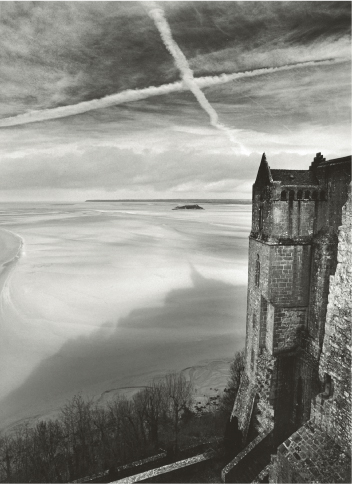15 Mystical Photography
The word mystical is quite often used without really knowing what it means.
You often hear, “This image is mystical indeed.” And by that, people mean moody or mysterious rather than mystical. What then is the original meaning of the word mystical? The original meaning derives from religion and encompasses the idea of a personal, individual union with God. In every religion, there are mystical currents that try to reach a spiritual state through meditation, immersion, or a cleansing of the soul that opens it up for so-called divine experiences. What this really implies naturally goes beyond the scope of this book.
The most famous Christian mystic was Master Eckhart, who repeatedly retreated to solitude to empty his senses from overload and to make himself more sensitive and open for experiencing the “divine.” The concept of God is not used in the conventional sense here; rather, it stands for an idea that there is another, expanded level behind the world as it is perceived by our very restricted five senses. The idea of such a level lying beyond what we can perceive is very old. It crops up in many antique civilizations and philosophic schools; for example, the ancient Indian sacred texts, the Vedas, describe the world as perceived by our five senses as an illusion, or as the curtain to Maya, the name of the world that at one point will be revealed so we can recognize the world perceived by us as only a blinding veil.
However, the anthroposophical movement of Rudolf Steiner also takes up this idea of a delicate world that can be discerned by making the inner self more sensitive. Rudolf Steiner claimed that it was possible to glimpse a so-called spiritual world lying beyond the material one. He thought that every human had a sensitivity with which he could perceive phenomena from the spiritual world after certain training. This may sound off-beat at first, but if you realize that the world is constantly being permeated by all kinds of electromagnetic waves, and that you can perceive only a fraction of them with your senses, then you realize that many wavelengths exist beyond your perception.
Thus, it is not surprising that even modern science questions our apparently durable world of matter. After the world of physical objects is penetrated, the solid world of things disintegrates into the dance of the atoms.
This existence beyond the veil of the physical world—whatever shape it may have—can be described as the metaphysical world. Aristotle, and many other philosophers, reflected about metaphysics. The German philosopher Karl Jaspers even devoted an entire work to metaphysics. The concept of metaphysics is similar to mysticism. Mysticism comes from religion, whereas metaphysics deals with the quest to find out if there is something beyond the world perceived by the senses. Maybe the concept of metaphysics has a more neutral meaning than mysticism because the latter does not necessarily deal with the divine and is therefore easier to be accepted by atheists.
For photographers, the issue here is whether you can reach into these mystical or metaphysical dimensions or at least hint at them. The connection of photography and metaphysics is by no means far-fetched and has even found a place in the history of photography. Herbert List was certainly at the forefront when he talked of “fotografia metaphysica.” Although strongly influenced by surrealism, he took one step further with his “fotografia metaphysica” in the sense that he became interested in the “magic of the appearance.” With this “magic,” he tried to hint at other dimensions of existence and reach to the very bottom of things. In his photos, he placed objects in strange, unfamiliar contexts or staged encounters between fragments from reality that he uprooted from their origins. One of his best-known photos is Santorini, where he shows a fish swimming in a water-filled glass vase that sits atop a balustrade with a view of the wide, sparkling Mediterranean.
Herbert List was intensely interested in Greek mythology, so it’s not surprising that he made impressive photos of ancient Greek ruins. However, even these photos show much more than just the object; they point not only to another time, but also to another level of being through the magical composition of the lighting. He also hinted at metaphysical symbolism through the photographic interplay of covering and uncovering. In other photographs, he used mirrors to show the juxtaposition of mirror images and reality.
Needless to say, photography is—superficially seen—the medium that deals exclusively with visible reality, and yet it can hint at other levels, as you will see in the following examples.

Sign
The first example (figure 15–1 and figure 15–2) shows a cloud front moving above an arid landscape that gives the image a magical effect. Two marked streaks of clouds cross a vapor trail; the right trail is finger shaped, and toward the lower end you can even discern the shape of a fingernail. An interpretation of a “sign of God” would naturally be a clichéd interpretation. However, that such a clearly recognizable finger in the sky suggests the mystical is certainly indisputable.
This photo was taken digitally and all technical means at my disposal were used to emphasize the effect of the sky. First of all, the polarizing filter was turned 90 degrees to intensify the contrast between sky and clouds. During black and white conversion, the Photoshop red filter preset was used. The pictorial effect achieved resembles that of a red filter on an analog camera. If such an image is converted this way, it is essential to have a TIFF file converted from the RAW mode. If this photo had been taken in JPEG mode, unacceptable noise would have been created in the image upon conversion using a red filter effect, and the tonal value gradations would not have been fluid. In spite of the fact that the red filter conversion achieves a magical effect in a TIFF file, the transitions in the sky are just fluid enough to justify this conversion. In this photo, the contrast was increased a little as well. A less effective pictorial effect is achieved in a photo that was converted without applying a filter effect, as you can see in the smaller print (figure 15–1).
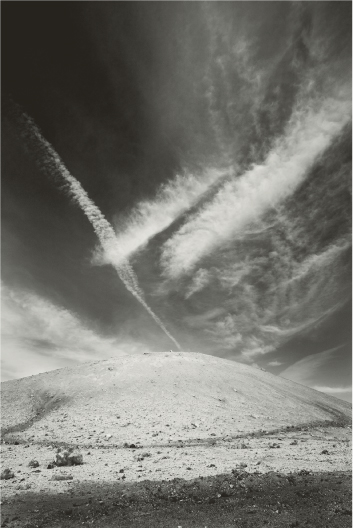
Angel as Symbolic Figure
Many years ago, the entire Hamburg suburb of Moorburg became the victim of the wrecking ball so that the port of Hamburg could be expanded. Only the church and cemetery were left standing. This exclusion shows that even in our rational, secularized age we still respect places of worship. In figure 15–3, you can see the silhouettes of a statue of an angel in the cemetery and the form of the church standing out against a dark and dramatic sky. The angel dominates the composition, symbolically raising a hand in front of the church as if wanting to protect it.
The idea of angels lies at the core of Christian doctrine, but it’s also quite important in anthroposophy or other esoteric disciplines. It is amazing how many people believe in the existence of angels in our Western world today.
In this photo, the angel should naturally be understood as only a symbol, as a figure that may be an agent between the world as perceived by the senses and the invisible metaphysical world. Regardless of how this world may appear, the photo points to it, hints at its existence, and may motivate the viewer to think about the numerous biblical or mythological stories that have dealt with the idea of angels.
This photo was also taken with the 24 mm wide-angle lens under strong backlighting. The sky had to be burned in quite a bit in the darkroom.
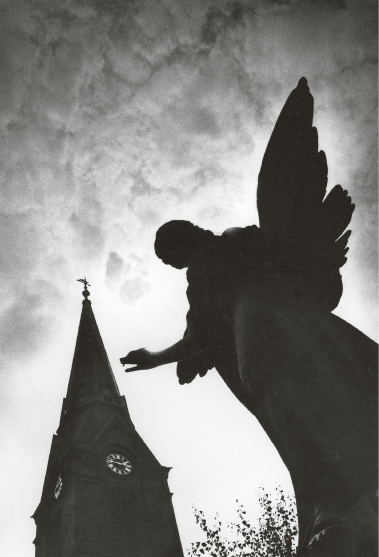
Transience
The photo in figure 15–4 taken in an Irish cemetery shows transience: A tombstone has always been the symbol of the transitory element of human life and raises the question of the existence of the hereafter. What happens after death? Does the soul survive? Are the promises of religions true or not? Nobody can answer these questions with certainty. “Believe in everyone who searched for truth, but trust no one who has found it,” remarked German journalist Tucholsky. And yet, a mystical photograph is capable of raising existential questions despite the fact that it cannot answer them. This image is not just about the passing of human life but also about the impermanence of the tombstone itself; its broken upper part lies simply by the pedestal.
The photo was taken digitally at f/16 with the 25 mm focal length of a 17–40 mm L lens made by Canon. It was converted using the Photoshop yellow filter preset. I selected the sky using the Polygonal Lasso tool with a feathered edge setting of 250 pixels and darkened it significantly. I then selected the upper part of the tomb-stone using a 50-pixel feather setting and brightened it a little. These are the steps that produced the wonderful mood in the finished image.
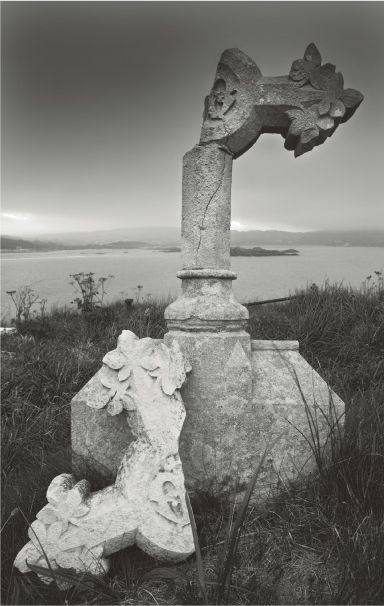
Stony Spiral in the Sea
Photos without obvious religious symbols but with a mystical message can also be created. Nobody knows the origin of this spiral on Lanzarote (figure 15–5); it may be the product of land art or a yogi group. In any case, this spiral is somehow out of place on a white, sandy beach; it is puzzling and alien to the viewer. The spiral is a basic and important shape not only in mathematics and biology but in social science as well. There are Archimedean and logarithmic spirals in mathematics, but especially in nature the spiral is a basic element because many plants have spiral structures. This shows that the spiral is an essential component of creation from which many different natural elements originate and develop. Therefore, this photo not only puzzles the viewer, but also invites the viewer to think about deeper connections. The photo was easily and minimally composed because it contains only four elements: the spiral, the sea, the sky, and the bright clouds.
The photograph was taken with the 35 mm lens of an analog Mamiya 645 camera (which corresponds roughly to a 21 mm small-format lens) and a red filter.
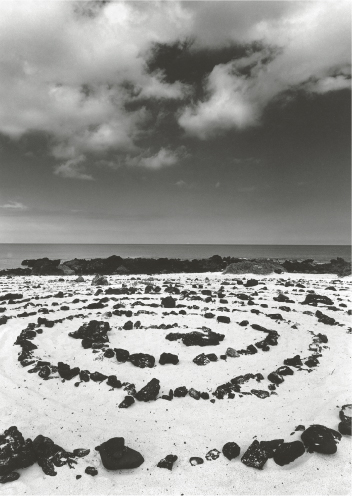
Enigmatic Relic
The photo in figure 15–6 also has a metaphysical personality because it leads directly to the enigmatic, invisible, and past world. This relic near Egridir Lake in Turkey forces the viewer to ask questions: What is the importance of this architectural relic? What used to stand here? Why is there a power line up there on the structure? These are questions that cannot be readily answered. The backlighting emphasizes this enigmatic quality. The dark sky with the bright, fleecy clouds intensify the pictorial effect of this photo. The mood of this image could be described as mystical, and by the end of this paragraph the reader will surely conclude that the original meaning of the word mystical does not really fit here. Maybe enigmatic is a better choice. Photography has limits that will always remain in the realm of the visible, but it is nonetheless capable of interpreting the visible world in such a way that the invisible is hinted at, and existential issues about borderline areas can be raised such as the existence of God, the mystery of time, or transience. As is the case with the nature of pictorial language, the questions remain, and the answers are never one-dimensional or dogmatic, but ambiguous and open.
The photograph was taken with an analog camera, a 20 mm wide-angle lens, and a red filter. Yet, in spite of this red filter, the sky had to be burned in toward the top in the darkroom so it could unfold its full effect.
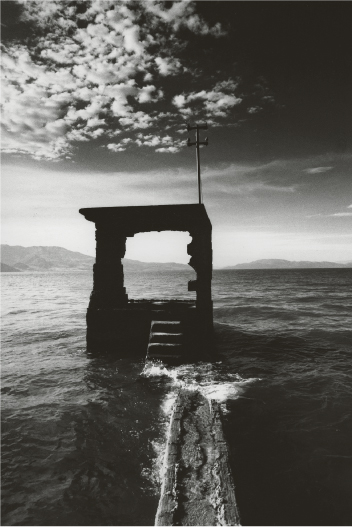
Cross in the Sky
The sky is vital in photographs because it leads to infinity, and infinity is a concept beyond human comprehension. Generally, a photo with many clouds creates a certain mood, sometimes even a dramatic mood. In the image in figure 15–7 the sky is dominated by the shape of a cross, formed by the vapor trails of two crossing airplanes. To the right, you can see an old, massive wall whose shadow on the mud flats indicates that it is part of a church. Against this background, the cross in the sky acquires another meaning; it becomes a sacred symbol to the other set pieces in the photo. Mont Saint Michel exudes an impressive sacred effect because the giant rock on which it was built rises above the surrounding mud flats in the middle of the Normandy coast. Taking the shot at precisely the right instant strengthened the sacred effect in this photo. The crossing of two airplanes in the sky was quite unexpected. Without the cross in the sky, the photo would have been only half as interesting.
The photo was taken with a 35 mm super-wide-angle lens of the analog Mamiya 645 (which corresponds roughly to a 21 mm small-format lens). A red filter plus darkroom burning of the sky intensified the mystical effect of the image.
